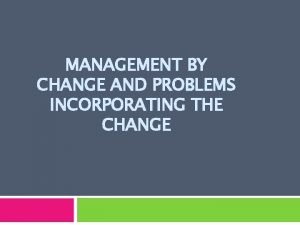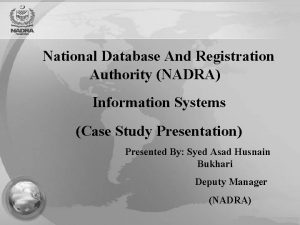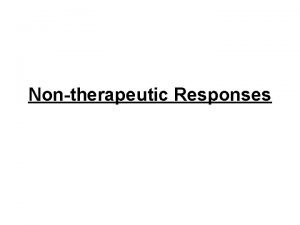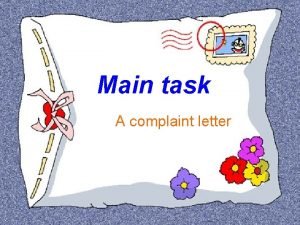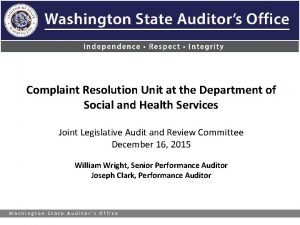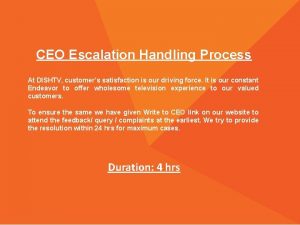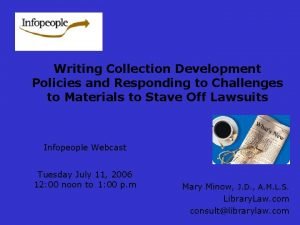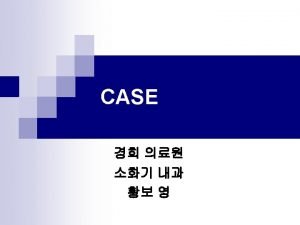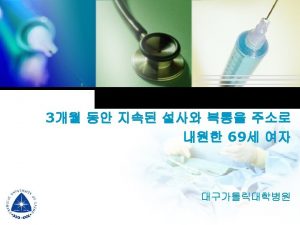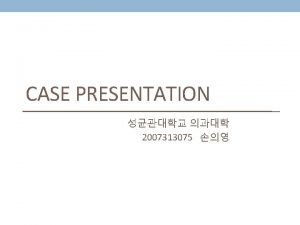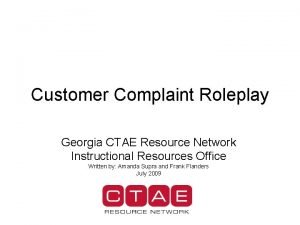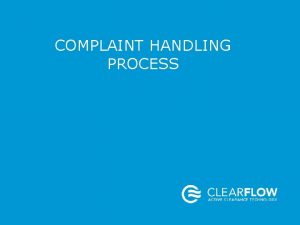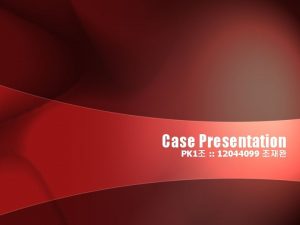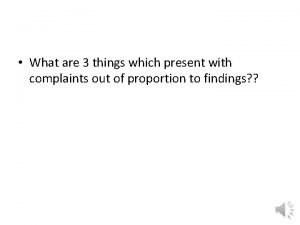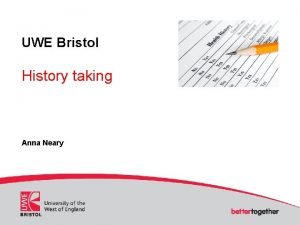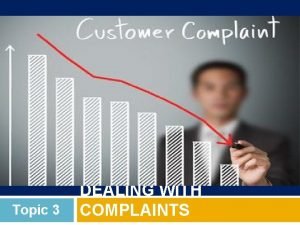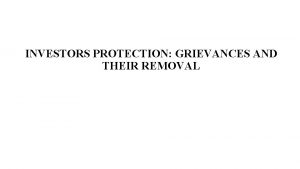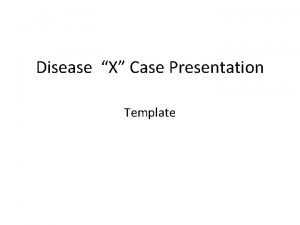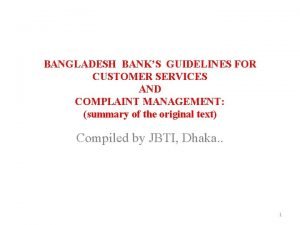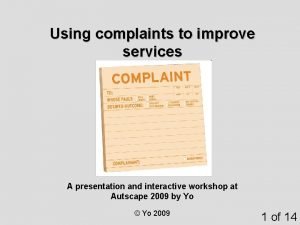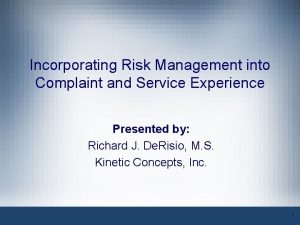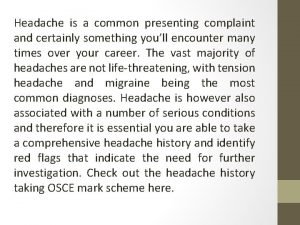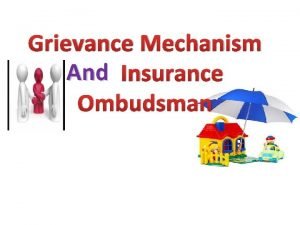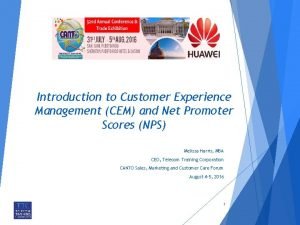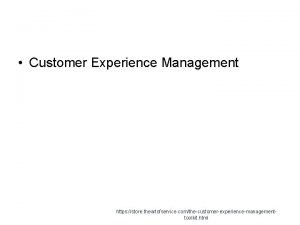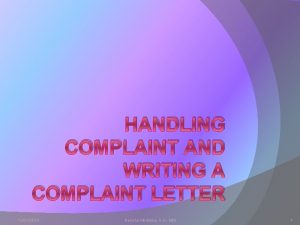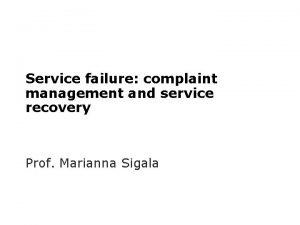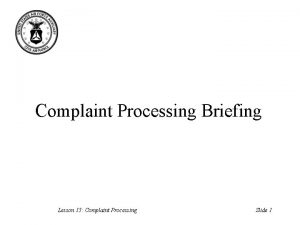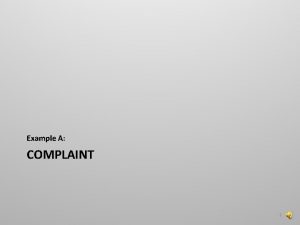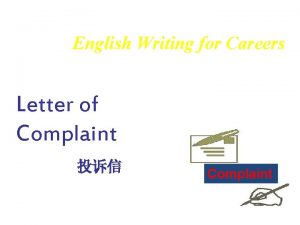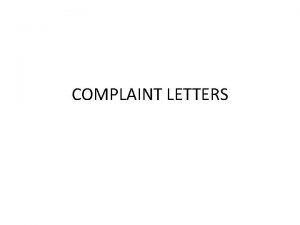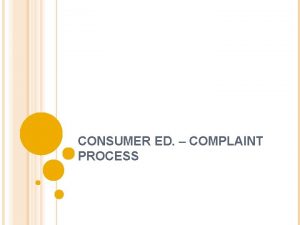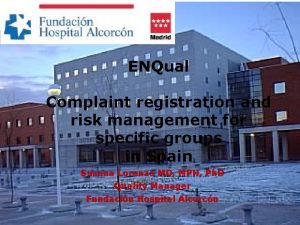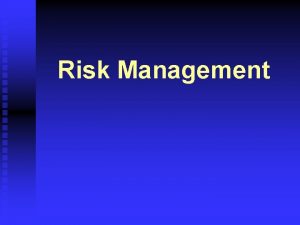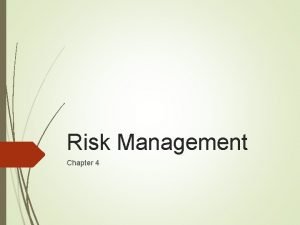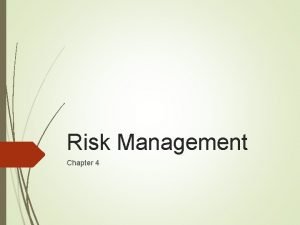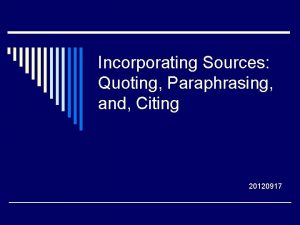Incorporating Risk Management into Complaint and Service Experience




































































- Slides: 68

Incorporating Risk Management into Complaint and Service Experience Presented by: Richard J. De. Risio, M. S. Kinetic Concepts, Inc. 1

Management of Complaint and Service Experience A Compliance Headache? or The Foundation for Continuous Improvement and Risk Reduction? 2

Getting Into a Risk Mitigation State of Mind Product Improvement Preventive Action Compliance Assurance Complaint Management Product Liability Risk Corrective Action Business Interruption Risk 3

Discussion Topics • • • Complaint Handling Survey Benefits of an Effective System for Management of Complaint and Service Experience Designing Risk Management Into Your Complaint and Service Monitoring System Field Experience Process Flow Product Life Cycle Risk Management 4

Discussion Topics • • Reducing Safety Risk Reducing Liability Risk Reducing Business Risk Reducing Compliance Risk – Understanding the Regulation – Warning Letter Citations • Complaint and Service Metrics 5

Complaint Handling Survey Findings Sponsored by Compliance-Alliance www. compliance-alliance. com Nancy Singer 6

Number of Employees 7

What was the breakdown of device classifications for the first 200 firms that answered survey? 8

Resources 9

Benefits of an Effective Complaint and Service Management System • • • Assure highest possible levels of safety and effectiveness; Facilitate identification and implementation of product improvements; Inspire employees to report product performance issues and adverse events promptly; Establish a system that effectively and efficiently meets regulatory requirements; Minimize exposure to product liability lawsuits; and Reduce the Cost of Poor Quality. An Essential Risk Management Tool! 10

Complaint Management Contribution to Continuous Improvement • • • Product Design Product Reliability Process Uniformity and Reproducibility – – – • Design Manufacturing Installation Service Systems Exceeding Customer Expectations 11

Complaint Management Contribution to Reducing Risk • • Risk to Patients and Users Business Risk Liability Risk Compliance Risk 12

“Designing-In” Risk Management New Product Idea Inputs • Similar Product Experience –Yours –Competitors’ • Expert Opinion –Medical –Engineering –Scientific –Legal Risk Assessment (Initial) • FTA • DFMEA Risk Assessment (Final – Pre-Launch) Revised based on bench testing, clinical research, experience with competitive products. At each stage, consider how this information can be used as a baseline for monitoring risk on an ongoing basis. • FTA • FMEA, FMECA, PFMEA 13

“Designing-In” Risk Management Quality Plan – Risk-Related Elements: • • • Supplier Nonconformances Production Nonconformances Post-Market Surveillance Complaint and Adverse Event Investigation Trending Complaints & Adverse Events Trending and Analysis of Service Experience Failure Investigation/Analysis Corrective and Preventive Action Reviewing Current Experience with Current Risk Assessment Tools Periodic Management Review of Risk Levels 14

“Designing-In” Risk Management Using Risk Assessment Tools for Management of Complaint and Service Experience: 1. DFMEA as an Objective Standard • Use the DFMEA severity level when setting “alert triggers” for taking action: – – – Detecting an adverse trend Conducting a failure investigation Establishing root cause of failure Reporting to senior management Filing a mandatory adverse event report 15

“Designing-In” Risk Management 2. Recognizing that the original estimate of severity level was inaccurate: • • • Complaint and adverse event reports Adverse events associated with service calls Clinical trial experience Published literature User feedback Competitive experience 16

“Designing-In” Risk Management 3. Recognizing that the original estimate for probability of occurrence or downstream detectability was inaccurate: • • • Complaint reports Production nonconformances Out-of-box failures Service, repair and warranty experience Laboratory testing User feedback 17

“Designing-In” Risk Management 4. Effective Use of Management Reviews to Assess Risk • Complaint Trends – – – Product categories Reported failure modes Confirmed root causes Adverse event trends Event types » » » Death Injury Serious Malfunction – Care Setting 18

“Designing-In” Risk Management 4. Effective Use of Management Reviews to Assess Risk (continued) • Corrective and Preventive Actions – Effectiveness of Prior CAPAs (Trends) – Timeliness of CAPAs in Progress – Need for New CAPAs • Shop Floor Quality – Scrap – Rework – Process Variability 19

“Designing-In” Risk Management 4. Effective Use of Management Reviews to Assess Risk (continued) • Service and Repair Experience – Analyze Data from all Sources » Field service centers » Home office repair facility » Contract service organizations » Hospital experience (where available) – Pareto Diagrams » Product line » Part or subassembly » Labor – Discuss all Safety-Related Service Issues » Incident investigation results » Planned and ongoing corrective actions 20

“Designing-In” Risk Management 5. Management Review Risk Assessment • • Products and Processes Conform to Existing Risk Assessment Product Experience (Trends and Individual Events) Does Not Signal Need to Reassess Risk CAPAs are Appropriate for Maintenance of Existing Risk Levels External Inputs Support Levels for Severity and Probability of Occurrence in Current Risk Assessment – – – Published reports, articles Conference presentations Reports concerning similar competitive devices 21

Field Experience Flow Chart Customers Sales Force Field Clinical Representatives Product Issue Response Team • Technical Service • Medical • Complaint Management Service Technicians Technical Support Service Work Order Entry Into QMES Software Complaint Management Clinical Support Inquiry Adverse Event Investigation and Reporting See Next Slide 22

Field Experience Flow Chart From previous slide Complaint Investigation Product History Same/Similar Lot DHR Common Component History Human Factors Including User Error Labeling Review Device Failure Investigation and Analysis of Root Cause CAPA Consideration Close Complaint Evaluate Trend vs. Current Risk Assessment 23

Product Issue Response Team (P. I. R. T. ) • • Designed to Assure That a Trained Professional Gathers Essential Safety, Performance and Customer Feedback Issues Co-location of Specialists – Medical Personnel – Nurses with Product and Therapy Knowledge – Engineers – Provide Expert Problem-Solving Support – Complaint Analysts – Document and Investigate Complaints 24

Product Issue Response Team (P. I. R. T. ) • Use of Scripts to Assure That Needed Information is Captured During the Call in a Consistent Manner Among P. I. R. T. Personnel and from Caller to Caller – Adverse event reports – Requests for clinical consultation – Product performance complaints – Service technical support 25

Product Issue Response Team (P. I. R. T. ) • Co-location Facilitates Communication – Access to products for hands-on training for reported failure modes. – “Bullpen” discussions of emerging failure modes. • Reduced Dependence on Customer Service Personnel – Less opportunity for errors or omissions – Removes conflict with time-based goals – Simplifies training challenges related to skills and turnover 26

Product Issue Response Team (P. I. R. T. ) • Allows Company to Harvest those Rare “Pearls of Wisdom” that Could Be Lost Later – Complainant is a difficult-to-reach, night-shift nurse – Delay results in complainant’s inability to remember details of the complaint or adverse event – Risk management at facility prohibits communication – Complaint device has been misplaced, corrupted or discarded 27

Reducing Patient/User Safety Risk Summary • Assess All Sources of Safety Inputs – – – • • • Complaints and Service Experience Adverse events Clinical inquiries Published literature Conference proceedings Compare Severity and Rate of Incidence to Current Risk Assessment Consider Revising Risk Levels Using Established Procedures Ongoing Review of Risk-Based Actions During Management Reviews 28

Reducing Business Risk • Types of Business Risks – High Cost of Poor Quality (COPQ) • Returns • Scrap • Reprocessing – Loss of Sales Revenue and Customer Goodwill – Field Correction or Removal (Recall) – Unforeseen failures at primary, secondary or tertiary suppliers • Use Complaints as Early Alert to Source of Business Interruption – Process Out of Control – Supplier Component or Subassembly Failing to Meet Specifications – Contract Manufactured Device or Service Not Meeting Specifications – Failure Mode Poses Risk to Health – Unanticipated service issues: parts, cost, required skills 29

Reducing Business Risk • Predictive Tools – Use DFMEA, FMECA, PFMEA to Supplier Level to Predict Critical Outputs – Establish Appropriate Risk Mitigation Steps » Verification & Validation » Process Controls » Testing as appropriate – Establish Sensitive Triggers to Alert at Low Cumulative Number of Complaints – Predict Critical Failure Interruptions Such As: » Field Corrections and Removals » Line Stoppages » Customer Conversion to Competitive Product 30

Reducing Product Liability Risk • Establish, Maintain and Follow Effective Procedures to Demonstrate Due Diligence in Investigating Complaints – – – • Complaint Handling Adverse Event Investigation and Reporting Failure Investigation Root Cause Analysis Corrective and Preventive Action React Quickly and Consistently to Adverse Event Reports – Use Standardized AE Investigation Questionnaires – Fully and Clearly Document Association Between the Event and the Device – Be Cautious Regarding Attributing AE to User Error (Was it Actually Design? Labeling? Training? Malfunction? Manufacture? ) 31

Reducing Product Liability Risk • Comply with Mandatory Reporting Requirements Promptly, Consistently and Accurately – Review Reporting Criteria with Clinical Experts – Ensure That a Complaint File is Opened • Demonstrate Willingness to Take Necessary Corrective Actions to Improve Products and Their Labeling – Actions Meet the Test: “Is the Company Doing Everything Reasonable to Warn and to Protect? ” – Corrective Actions are Taken Quickly and Audited for Effectiveness • Address Servicing Issues Responsibly – Assure that service operations are reliable and accessible – Respond to trends effectively » Analyze increase in repair frequency » Identify troublesome components 32

Reducing Compliance Risk • • • Understand the Regulation! Read 21 CFR 820. 198 – line by line with a cross-functional team Read the preamble! Verify that every requirement is supported by an established procedure The word “complaint” appears 82 times in the Quality System Preamble and Regulation 33

820. 3(b) – Complaint Definition “Complaint means any written, electronic, or oral communication that alleges deficiencies related to the identity, quality, durability, reliability, safety, effectiveness, or performance of a device after it is released for distribution. ” [Compare ISO 13485: 2003: § 3. 4: Customer Complaint: “…written, electronic or oral communication that alleges deficiencies related to identity, quality, durability, reliability, safety or performance of a medical device that has been placed on the market…”] 34

Regulatory Requirements 21 CFR 820. 198(a) • • • Maintain complaint files Establish and maintain procedures Establish a formally designated unit Complaint handling procedures shall ensure that: • Process complaints in a uniform and timely manner; • Document oral complaints upon receipt; • Evaluate complaints for MDR reportability. 35

What is our goal to close complaints? Days 36

How do we receive complaints? 37

Who’s giving us this important feedback on our products? 38

How often do we acknowledge complaints? No = Yes = 39

Boston Scientific January 2006 • Failure to establish and maintain procedures for receiving, reviewing, and evaluating complaints by a formally designated unit to ensure complaints are processed in a uniform and timely manner. – Your SOP indicates that a complaint should be documented within [redacted] hours or less of "becoming aware" of the complaint. – Specifically, we observed time differences that ranged from 4 weeks to 11 1/2 months after you first became aware of the complaint. 40

Haemacure Corporation January 2005 • Your firm failed to establish and implement complaint handling procedures as required by 21 CFR 820. 198(a). Your Complaint Report form fails to include the need for review and/or investigation, who would conduct the investigation, their conclusions and any response back to the complainant. 41

21 CFR 820. 198 – Regulatory Requirements (continued) (b) Each manufacturer shall review and evaluate all complaints to determine whether an investigation is necessary. When no investigation is made, the manufacturer shall maintain a record that includes the reason no investigation was made and the name of the individual responsible for the decision not to investigate. [Compare ISO 13485: 2003, § 8. 5 – Improvement: “If any customer complaint is not followed by corrective and/or preventive action, the reason shall be authorized (see 5. 5. 1) and recorded (see 4. 2. 4)”. ] 42

Complaint Investigation When Complaint Investigation is NOT Required: • Documented evidence of a previous investigation(s) for similar complaints with established CAPA • Product was not manufactured or distributed by firm • Issue is related to billing, shipping, routine servicing or delivery, or product enhancement suggestions – These inputs are forwarded to appropriate department (CAPA) • Reported information does not meet the definition of a complaint 43

Rationale for Closing a Complaint Without a Corrective Action • High correlation with complaints that have an established corrective action – Is CAPA still open? – Was complaint unit manufactured before or after CAPA implementation? • • If product was manufactured after implementation of CAPA, QE must evaluate Confirm alleged failure mode is consistent with subject CAPA 44

Survey Question: Why Are Some Complaints Not Investigated? • • • 40% “Failure investigation is already open” 53% “Adequate investigation performed” 52% “CAPA already initiated for same failure mode” 23% “Device was not properly used” 34% “Complaint doesn’t involve a possibility that the device did not meet specs. ” 45

Con. Med June 2005 • Failure to analyze complaints, returned product, and other sources of quality data to identify existing and potential causes of nonconforming product, or other quality problems. 21 CFR 820. 100(a)(1). Your firm fails to conduct an appropriate analysis of complaints and reports of nonconforming product in that: – A. You fail to examine complaints by failure mode, and multiple failures reported for devices from a single lot are not individually analyzed. 46

Ways That Firms Get Devices Back! • • • Be responsive: have a courier or salesperson pick up the product Provide free shipping and product replacement or credit Educate the customer on company’s corrective and preventive actions Continue to follow up with the customer until firm gets the product back Customized shipping containers to provide prompt, damage-proof return of components from service centers 47

When do we consider complaints to be closed? 48

If patient safety could be affected, how many complaints for the same failure mode could trigger a failure investigation? 49

Complaint Investigation Extent of the investigation is a function of risk potential • • • Device History Record review Risk Analysis to determine severity/risk of failure Age, intended life or expiration date of product Service and repair history Review of recent upgrades or field corrections Review of recent design and process changes Review of labeling including warnings, precautions Review of previous corrective actions Review and timing of previous corrective actions 50

Complaint File Review Final Quality Assurance Review of the File • • Confirm required information is included MDR/Vigilance report and investigation, if applicable Failure codes assigned for use in trending Risk analysis reviewed to determine if failure mode is occurring with greater frequency or severity than anticipated Review DHR findings Confirm completion of failure investigation and summary Response generated for internal and/or external customers, if requested Rationale for complaints remaining open beyond closure goal will be revisited weekly until closed 51

How often do we tell complainants what we’re doing? 52

21 CFR 820. 198 – Regulatory Requirements (continued) (c) Any complaint involving the possible failure of a device, labeling, or packaging to meet any of its specifications shall be reviewed, evaluated, and investigated, unless such investigation has already been performed for a similar complaint and another investigation is not necessary. 53

Complaint Handling Upon Receipt • • Review to determine if report meets the definition of a complaint Document product identity: product code, lot/serial number Assign an “alleged failure mode” code for tracking Evaluate to determine if complaint is potentially reportable Evaluate to determine if an investigation is required Establish priority for investigation (adverse event, failure to meet specs, severe business risk = HIGH) Determine if there is a CAPA related to the complaint (open? , closed? ) 54

Seecor, Inc. December 2005 • Your firm received two oral user reports that alleged the possible failure of two AC fibrillators occurring during surgery. You explained to the FDA investigators that the devices "burned up" due to user error. However, your firm failed to: (a) conduct and document a formal complaint investigation; (b) document the nature and details of the incidents; (c) document your follow-up with the users; (d) document your justification for why you did not consider the oral user reports as complaints; and (e) document your determination of whether any adverse medical event had occurred during surgery. 55

Life. Scan December 2005 • Failure to review, evaluate, and investigate any complaint involving the possible failure of a device, labeling, or packaging to meet any of its specifications. – Patient's nurse contacted your company to report the One. Touch Ultra was reading high and patient was taken to the Emergency Room. This complaint was closed without performing an investigation. – Patient's daughter contacted your company to report the One. Touch Ultra was set in the wrong units of measurement. Complaint was closed without performing an investigation. 56

21 CFR 820. 198 – Regulatory Requirements (continued) (d) Any complaint that represents an event which must be reported to FDA under part 803 of this chapter shall be promptly reviewed, evaluated, and investigated by a designated individual(s) and shall be maintained in a separate portion of the complaint files or otherwise clearly identified. In addition to the information required by § 820. 198(e), records of investigation under this paragraph shall include a determination of: 1) Whether the device failed to meet specifications; 2) Whether the device was being used for treatment or diagnosis; and 3) The relationship, if any, of the device to the reported incident or adverse event. 57

Are service reports that represent an MDR processed under 820. 198? 58

Tyco Healthcare Group September 2005 • • Failure to establish, maintain, and implement procedures for receiving, reviewing, and evaluating complaints, as required by 21 CFR 820. 198(a). For example, the following service reports received by the firm and classified as complaints were not evaluated to determine if the complaints represented events which were required to be reported to FDA as MDRs: 59

Proactive Product and Safety Surveillance • • • Don’t Be Satisfied with Passive Customer Experience or Service Reporting Develop Tactics for Eliciting the Information Needed for Continuous Improvement Ensure that the Corporate Culture Recognizes and Values the Need to Report Safety, Compliance and Quality Issues: – Customer complaints – Adverse Events – Service trends and unanticipated events • Provide Feedback to Internal and External Customers Regarding Action Taken on Their Issue 60

Metrics: Complaint Process Management and Product Performance 61

Complaints Open/Closed Still a week to go… Dec ’ 04 – Feb ’ 05: Complaint process redesign period – few complaints closed. May ’ 05 – Aug ’ 05: Campaign to increase complaint and service experience reporting from all sales, service and customer support personnel. 62

Open Complaints by Month Increase in complaint input preceded increases in staff support requiring extra effort to close complaints in a timely manner. Advantage: more detail regarding known failure modes; additional returned samples for analysis. 63

Status of Open Complaints Complaint department’s tool for identifying root cause of open complaints. 64

Disposables – Dressings (Sample Presentation of Metrics) 65

Disposables – Packaging (Sample Presentation of Metrics) 66

Strategies for Success • • Leadership Training Standardized Complaint Reporting and Handling Processes Cross-Functional Complaint/CAPA Quality Improvement Teams Periodic reviews of system performance Clear published metrics to instill awareness An effective means for return of complaintrelated devices 67

Questions, Answers, Discussion 68
 Methods of incorporating risk in capital budgeting
Methods of incorporating risk in capital budgeting Nn
Nn Credit risk market risk operational risk
Credit risk market risk operational risk Incorporating the change
Incorporating the change Incorporating quotes
Incorporating quotes Incorporating pronunciation
Incorporating pronunciation Incorporating in ohio
Incorporating in ohio Example of indirect experience
Example of indirect experience Imprinting meaning psychology
Imprinting meaning psychology Continuity vs discontinuity
Continuity vs discontinuity Nadra data acquisition form
Nadra data acquisition form Fiduciary investment risk management association
Fiduciary investment risk management association Risk map risk management
Risk map risk management Residual risk and secondary risk pmp
Residual risk and secondary risk pmp Business risk and financial risk leverage
Business risk and financial risk leverage Attributable risk formula
Attributable risk formula Attributable risk (ar)
Attributable risk (ar) Patient chief complaint
Patient chief complaint Examples of formal planning
Examples of formal planning Tone of complaint letter
Tone of complaint letter Cc chief complaint
Cc chief complaint The role of the complaint resolution unit (cru) is to
The role of the complaint resolution unit (cru) is to Dish tv complaint email id ceo
Dish tv complaint email id ceo Peter quince
Peter quince Patient cc
Patient cc Sample complaint form
Sample complaint form Sample complaint form
Sample complaint form Chief complaint of hemorrhoids
Chief complaint of hemorrhoids Diarrhea chief complaint
Diarrhea chief complaint Chief complaint of malnutrition
Chief complaint of malnutrition Handling complaint ppt
Handling complaint ppt Customer complaint student response worksheet
Customer complaint student response worksheet Complaint handling definition
Complaint handling definition Chief
Chief Complaint present
Complaint present History taking format
History taking format Complaint dialogue 3 person
Complaint dialogue 3 person Ommaverify.ok.gov
Ommaverify.ok.gov Complaint against depository participant
Complaint against depository participant Epso complaints
Epso complaints Chief complaint template
Chief complaint template Chief complaint present illness
Chief complaint present illness Bangladesh bank complaint cell
Bangladesh bank complaint cell Presenting complaint
Presenting complaint Complaint letter parts
Complaint letter parts Resolve complaint
Resolve complaint 21cfr820.198
21cfr820.198 Presenting complaint
Presenting complaint Irda complaint
Irda complaint Draw rmmm plan
Draw rmmm plan Risk avoidance insurance
Risk avoidance insurance Relative risk calculation
Relative risk calculation Inherent risks examples
Inherent risks examples Absolute risk vs relative risk
Absolute risk vs relative risk Activity sheet 2: stock market calculations
Activity sheet 2: stock market calculations Risk classification system
Risk classification system Pembiayaan risiko (risk financing)
Pembiayaan risiko (risk financing) The biggest risk is not taking any risk
The biggest risk is not taking any risk Business risk audit
Business risk audit Perceived service alternatives
Perceived service alternatives Evolution of soa
Evolution of soa Maturity model template
Maturity model template Elisabeth brinton
Elisabeth brinton Introduction to customer experience management
Introduction to customer experience management Introduction to customer experience management
Introduction to customer experience management Bernd schmitt customer experience management
Bernd schmitt customer experience management Non physical fences example
Non physical fences example Wharton insurance and risk management
Wharton insurance and risk management Data governance and risk management
Data governance and risk management



